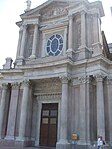Equestrian monument of Emmanuel Philibert
1838 sculpturesBronze sculptures in ItalyBuildings and structures in TurinEquestrian statues in ItalyOutdoor sculptures in Italy ... and 4 more
Sculpture stubsSculptures of men in ItalyStatues in ItalyStatues of military officers

The Equestrian monument of Emmanuel Philibert (Italian: Monumento equestre a Emanuele Filiberto di Savoia), commonly known as Caval ëd bronz (pronounced [kaˈvɑl əd ˈbrʊŋz], traditionally spelled Caval 'd brons; Piedmontese for 'bronze horse') rises in the center of Piazza San Carlo in central Turin, in the Piedmont region of Italy.
Excerpt from the Wikipedia article Equestrian monument of Emmanuel Philibert (License: CC BY-SA 3.0, Authors, Images).Equestrian monument of Emmanuel Philibert
Piazza San Carlo, Turin Centro
Geographical coordinates (GPS) Address External links Nearby Places Show on map
Geographical coordinates (GPS)
| Latitude | Longitude |
|---|---|
| N 45.06774 ° | E 7.68258 ° |
Address
Emanuele Filiberto
Piazza San Carlo
10123 Turin, Centro
Piedmont, Italy
Open on Google Maps











